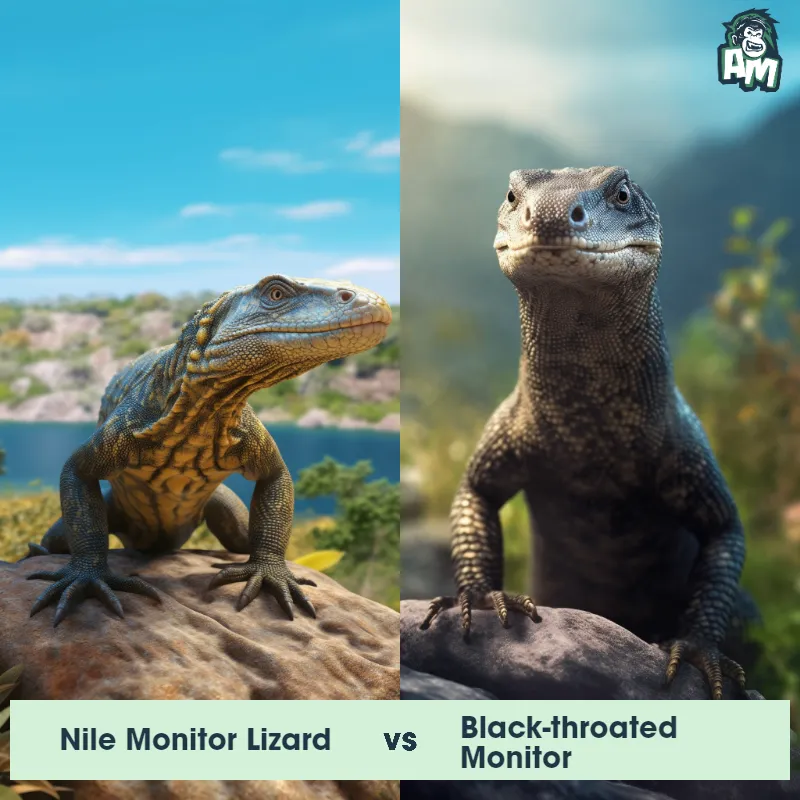The Black-Throated Monitor
The Black-Throated Monitor, scientifically known as Varanus albigularis, is a large lizard belonging to the Varanidae family. This species can be found in various regions of Africa, such as South Sudan, Kenya, Uganda, and Tanzania. With a total length reaching up to 6 feet, including the tail, the Black-Throated Monitor is a robust and powerful reptile. It has a dark brown or black body covered in scales, with distinct yellow or orange bands or spots on its back. This monitor lizard possesses a long, muscular tail, powerful limbs, sharp claws, and a prominent black throat, which gives it its common name.

| Black-Throated Monitor | |
|---|---|
| Size | Up to 6 feet (1.8 meters) |
| Weight | Up to 40 pounds (18 kilograms) |
| Speed | Speed: 15 mph (24 km/hr) |
| Key Strength | Powerful jaws and sharp claws |
| Biggest Weakness | Slow movement on land |
| Scientific Name | Varanus albigularis |
| Family | Varanidae |
| Habitat | Terrestrial |
| Geography | Africa |
| Diet | Carnivorous, feeds on insects, small mammals, and birds |
| Lifespan | 15 years - 20 years |

The Black-Throated Monitor
The Black-Throated Monitor, scientifically known as Varanus albigularis, is a large lizard belonging to the Varanidae family. This species can be found in various regions of Africa, such as South Sudan, Kenya, Uganda, and Tanzania. With a total length reaching up to 6 feet, including the tail, the Black-Throated Monitor is a robust and powerful reptile. It has a dark brown or black body covered in scales, with distinct yellow or orange bands or spots on its back. This monitor lizard possesses a long, muscular tail, powerful limbs, sharp claws, and a prominent black throat, which gives it its common name.
Fun Fact: Despite their considerable size, Black-Throated Monitors are incredibly agile climbers and capable swimmers, thanks to their long and muscular tails and strong limbs, allowing them to navigate various environments with ease.
| Black-Throated Monitor | |
|---|---|
| Size | Up to 6 feet (1.8 meters) |
| Weight | Up to 40 pounds (18 kilograms) |
| Speed | Speed: 15 mph (24 km/hr) |
| Key Strength | Powerful jaws and sharp claws |
| Biggest Weakness | Slow movement on land |
| Scientific Name | Varanus albigularis |
| Family | Varanidae |
| Habitat | Terrestrial |
| Geography | Africa |
| Diet | Carnivorous, feeds on insects, small mammals, and birds |
| Lifespan | 15 years - 20 years |
Black-Throated Monitor Matchups
We use AI to simulate matchups between the Black-Throated Monitor and other animals. Our simulation considers size, strength, and natural predatory behaviors to determine the most likely outcome.

Can't find the Matchup you want?
Create Your Own MatchupBlack-Throated Monitor: Diet, Predators, Aggression, and Defensive Behaviors
What do Black-Throated Monitors eat?
Black-Throated Monitors are carnivorous animals that primarily feed on a diet consisting of insects, small mammals, birds, eggs, and sometimes carrion. They are opportunistic hunters and will also eat frogs, lizards, and other small reptiles when given the chance.
Do Black-Throated Monitors have any predators?
As adult Black-Throated Monitors are large and powerful predators themselves, they do not have many natural predators. However, younger monitors may fall victim to large birds of prey, snakes, and other monitor species. Human activities, such as habitat destruction and poaching, pose a significant threat to their population.
Are Black-Throated Monitors aggressive?
Black-Throated Monitors are known to be relatively calm and shy animals when left undisturbed in their natural habitat. However, if they feel threatened or cornered, they can become defensive and may show aggressive behavior. They have been known to deliver painful bites and scratches if they feel attacked.
Do Black-Throated Monitors fight?
Male Black-Throated Monitors may engage in fights with each other during the breeding season, typically to establish dominance or compete for mating rights. These fights can be intense and may result in injuries to one or both participants.
How do Black-Throated Monitors defend themselves?
When threatened, Black-Throated Monitors will use their large size, sharp claws, and powerful jaws to defend themselves. They may also puff up their bodies, hiss, lash their tails, or deliver bites to deter potential predators or threats.
What is the biggest weakness of Black-Throated Monitors in a fight?
Despite their size and strength, the biggest weakness of Black-Throated Monitors in a fight is their vulnerability to sustained attacks or injuries. While they have powerful defenses, prolonged fights or sustained injuries could leave them at a disadvantage, especially when facing larger predators or multiple attackers.
Fun Fact: One interesting aspect of the Black-Throated Monitor's behavior is its reproductive strategy. Unlike many reptiles, these monitors exhibit parental care, with the female laying a clutch of eggs and then remaining nearby to guard and protect them until they hatch, ensuring greater chances of the offspring's survival.
Fun Fact: Black-Throated Monitors are opportunistic predators, meaning they will feed on a wide range of prey items. Their diet primarily consists of small mammals, birds, reptiles, amphibians, and invertebrates. However, they have been observed consuming carrion, fruit, and even raiding bird nests to feed on eggs and chicks. This adaptability to their environment and wide-ranging diet contributes to their survival and success as a species.











